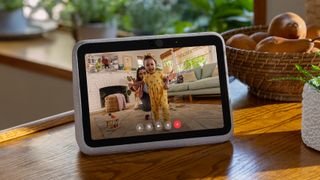The new Facebook Portal Go makes video calling on a smart display even better
Opinion: a portable smart display means video calls on the go

The beauty of video calling on a smartphone, whether you use Facetime, WhatsApp, or another service, is that you can move around during the call. Perhaps you’re catching up with friends on the way to the shops, or saying good night to the kids because you’ve had to work late.
However, a smartphone’s screen is relatively small, which means the video call isn’t the most pleasant experience, especially if there’s more than one person in the frame. The best smart displays make a great alternative device for seeing as well as hearing the other person, but it’s not possible to walk around while using one.
Until now, that is. Facebook has taken the wraps off its latest smart display, the Portal Go, and in a first for a smart display, it’s powered by a rechargeable battery and has a handle so you can carry it around while you’re on a call. Great if you want to move rooms to grab something, or check on the kids without ending the call.
It has a 10-inch screen and the same 12MP camera found on the previous Facebook Portal, which automatically pans and zooms to ensure you’re always in the center of the shot. Facebook Portal Go is priced at $199 / £199 / AU$279 and is available to pre-order now, with shipping on October 19.
At the same time, Facebook also unveiled a new version of its larger Portal+, which retains its 14-inch screen but has a smaller form factor, so it takes up even less space in your home. The Portal+ costs $349 / £349 / AU$519.
- Amazon Fire TV Cube finally supports Zoom video calls
- Here’s how to join a missed WhatsApp group call midway
- Find out how to make group calls with Alexa on an Amazon Echo

Calling on the go
Video calling certainly became more popular thanks to the pandemic. In the UK, the number of adults making video calls rose from 35% in February 2020 to 71% in May 2020, according to Ofcom’s Online Nations Report 2020. Furthermore, 38% of those were using a video calling service daily.
There’s no denying video calling from a smart display is a great way to stay in touch, but it does mean you lack the ability to move around during the call. Having grown up with a wireless landline telephone, and owned a mobile phone since I was a young adult, the concept of moving around while making a call is ingrained in me, as it allows me to multitask. For example, I might check in with my parents while cooking dinner, or swap jokes with my niece and nephew on the walk home from work.
Get daily insight, inspiration and deals in your inbox
Get the hottest deals available in your inbox plus news, reviews, opinion, analysis and more from the TechRadar team.
The camera on the original Facebook Portal could automatically pan and zoom to ensure you were always in the center of the shot when making a video call, which certainly helped if I wanted to move around the room, perhaps to grab a new item of clothing I wanted to show off on the call. In fact, it’s a function that Apple has duplicated with its Center Stage feature, which is available on the iPad Pro (2021) and the recently announced Apple iPad 10.2 (2021). Similarly, Amazon built on this with the Echo Show 10, which has a swiveling screen that will follow you around the room. However, none of these meant you could leave the room and continue a video call, without switching to another device - something the Facebook Portal Go rectifies.
The Facebook Portal Go weighs 3 lb / 1.4 kg, which is the same as the original Portal and is a comfortable load to carry from room to room.
We think battery-powered smart displays will certainly make life easier when it comes to video calling, and it’s something we think all models should have, and look forward to seeing how rivals such as Google and Amazon respond.
- Check out these great smart home device deals
Carrie-Ann Skinner was formerly Homes Editor at TechRadar, and has more than two decades of experience in both online and print journalism, with 13 years of that spent covering all-things tech. Carrie specializes in smart home devices such as smart plugs and smart lights, as well as large and small appliances including vacuum cleaners, air fryers, stand mixers, and coffee machines. Carrie is now a copy editor at PWC.

